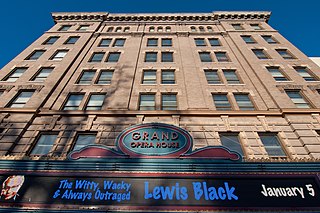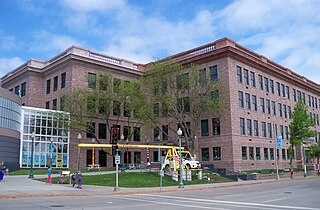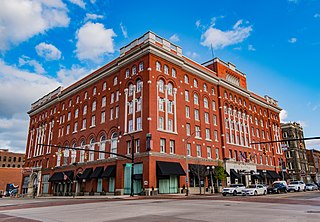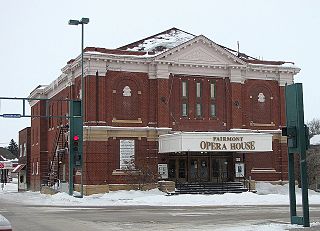
The Sunshine Building is a historic six-story building in downtown Albuquerque, New Mexico. It was built in 1924 by local theater owner Joseph Barnett and houses the Sunshine Theater as well as commercial space and offices. The Sunshine operated primarily as a movie theater until the 1980s, though it was also equipped for Vaudeville shows and other live performances. Since 1990 it has operated as a live music venue, hosting many notable acts. The building was listed on the New Mexico State Register of Cultural Properties in 1985 and is also an Albuquerque City Landmark.

The Lyric Baltimore is a music venue in Baltimore, Maryland, United States, located close to the University of Baltimore law school. The building was modeled after the Concertgebouw concert hall in Amsterdam, and it was inaugurated on October 31, 1894, with a performance by the Boston Symphony Orchestra and Australian opera singer Nellie Melba as the featured soloist. Beginning in 1904, it was also used for touring performances by the Metropolitan Opera, and from 1950, it was the home of the Baltimore Opera Company until that company's liquidation in 2009.

The Calumet Theatre is a historic theatre located at 340 Sixth Street in the town of Calumet, Michigan. It is also known as the Calumet Opera House or the Calumet Civic Auditorium. It is integral to, but a separate unit of, the Calumet municipal building. The structure was designated a Michigan State Historic Site in 1971 and added to the National Register of Historic Places in 1971. It is one of the 21 Heritage Sites which partners with the Keweenaw National Historical Park. The theatre was the original home of The Red Jacket Jamboree, an old-time radio variety show.

The Newberry Opera House, located in Newberry, South Carolina, is a fully restored historic building that is a live-performance space for popular artists, touring theatre companies, and local organizations. It is listed on the National Register of Historic Places in 1969.

The Grand Opera House, often called The Grand and originally known as the Academy of Music, is a historic opera house located in Macon, Georgia, United States. Listed on the National Register of Historic Places in 1970, it is now the performing arts center of Mercer University.

The Sunrise Theatre is a historic theater in Fort Pierce, Florida. It is located at 117 South 2nd Street.

The Egyptian Theatre is a theatre and concert venue in the western United States, located in Boise, Idaho. It has also been known as the Ada Theater. Inaugurated after its erection 97 years ago in 1927, it is the oldest theatre in the city. When it opened, the local press wrote that it "embodies the characteristic features of the land of the Nile, from the truncated pyramids which form the great pylons, to the lotus bud pillars with their ornate frescoes." The great lotus pillars flanking the screen are based on those of Karnak. The theatre has been renovated by Conrad Schmitt Studios.

The Washington Pavilion of Arts and Science opened in 1999 and houses an art gallery, concert hall, large-format theater, and science museum in Sioux Falls, South Dakota, United States. Its building, the former Washington High School, is listed on the National Register of Historic Places.

The Sesser Opera House is a historic theater located at 106 W. Franklin Ave. in Sesser, Illinois. The theater was built in 1914 to replace a previous theater, which had been built in 1904 and burned down ten years later. The theater was designed in the Mission Revival style and features a stucco interior, a large arch around the entrance designed to resemble an arcade, and a projecting eave topped with Spanish tiles. The theater was used for plays and vaudeville entertainment, traveling musicians, and showing films; its predecessor was the first theater in Sesser to be built with a projection room. The building also hosted local meetings and events as well as entertainment performed by community members.

Miller Symphony Hall is a 1,100-seat performing arts facility in Allentown, Pennsylvania that hosts the Allentown Symphony Orchestra. The hall was previously known as Central Market (1896), Lyric Theater (1899), and Allentown Symphony Hall (1959). In 2012, it was renamed for the Miller family, longtime owners of the hall and of The Morning Call newspaper.

The Grand Opera House, also known as The Grand or Masonic Hall and Grand Theater, is a 1,208-seat theater for the performing arts in Wilmington, Delaware, United States. The four-story building was built in 1871 by the Delaware Grand Lodge of Masons to serve as a Masonic Temple and auditorium. The construction cost was $100,000. It was designed in Second Empire style by Baltimore architect Thomas Dixon and incorporates symbolism from Freemasonry into the cast-iron facade. Its central pediment contains an Eye of Providence.

The Wilma Theatre is a cinema and events venue in Missoula, Montana, United States. It was built in 1921 by William "Billy" Simons and dedicated to his wife, light opera artist Edna Wilma. Designed by Norwegian architect Ole Bakke and his assistant H. E. Kirkemo, the steel-framed highrise features hallmarks of Sullivanesque architecture. The theatre is part of an eight-story complex that was the first steel-framed high-rise building in Missoula, and includes the main 1400-seat hall, a lounge, three banquet rooms, a restaurant, apartments and offices. The theatre interior is decorated with Louis XIV Style gilt trim.

The Great Southern Hotel & Theatre is an historic hotel and theater building in Downtown Columbus, Ohio. The building currently operates as the Westin Great Southern Columbus and the Southern Theatre.

Thompson's Opera House, also known as Brown's Hall, Brown's Opera House or the Gem Theater, is a small theater building in Pioche, Nevada. The Opera House is a wood-frame building built in 1873, attached roughly to the adjoining brick Gem Theater, a 1937 masonry cinema.

The Fairmont Opera House in Fairmont, Minnesota was built in 1901. Frank A. Day, editor of the Fairmont Sentinel, prodded local businessmen to establish an opera house starting in 1899. The Fairmont Opera House Company acquired the land in July, 1901 and began construction. The first grand opening was on February 11, 1902, with the opening show being "The Chaperone" performed by the Frank L. Perley Singing Comedians. From 1902 through 1912, it housed a variety of events such as traveling stock companies, local talent shows, graduation ceremonies, musicals, conventions, and political meetings. In 1912, W.L. Nicholas and Billy Hay became the managers, changed its name to the Haynic Theater, and began to show movies there. In 1926, the house was remodeled to accommodate live stock companies, road shows, and movies. Billy Hay died in 1926, and the opera house was rechristened the Nicholas Theatre, with a grand opening on July 27, 1927. The 1927 opening introduced an organ by Marr and Colton, complete with sound effects such as drums, a xylophone, car horns, horses' hoof beats, cymbals, and other novelties. The Nicholas Theater was used exclusively as a movie house until 1980.

Harlan Hall is a historic opera house located at 603 Locust St. in Marshall, Illinois. The opera house opened in 1872 to provide a venue for theatrical performances in Marshall. The building has an Italianate design with tall, narrow windows, wide bracketed eaves, and a steeply sloping roof. Both local and traveling theatrical acts performed in the theater, which also hosted concerts, public meetings, and other events. The opera house had a livery stable on its first floor for its patrons' horses, an unusual feature for contemporary theaters. In 1904, B. F. Johnson purchased the building and converted it to a movie theater; while it still served as a civic auditorium, the building no longer showed theatrical performances after this point. The building has since held a Moose Lodge, and its first floor has been converted to a commercial space.
The Corning Opera House is a theater located in Corning, Iowa, United States. This was the third of three opera houses built in town. The other two were built in the 1880s, and this one was completed in 1902. It was the only opera house in Corning by 1907, and it served as a theater until 1934. From its opening in 1902 until 1921 it staged theatrical performances, and from about 1920 to 1931 it showed movies. It also staged vaudeville performances and high school productions. The theater was located on the second floor. It features the original raked stage, seating on the main floor and the original horseshoe-shaped balcony, and it has a small stage and backstage offers a make up room and 2 green rooms. Historically, Commercial space was located on the main floor of the building, now the first floor features a conference room for renting and a commercial kitchen.

The Galva Opera House is a historic theater located at 334-348 Front Street in Galva, Illinois. Built in 1878, the theater opened as the Blue Ribbon Temperance Hall; by 1886, it had lost its association with the temperance movement and was known by its present name. Galva's location on two major railroad lines allowed traveling theatrical troupes to visit the theater; shows produced by local talent performed in the building as well. Local schools also used the building for their graduation ceremonies, sporting events, and school plays until Galva High School opened its own auditorium in 1932. The building was used as a roller skating rink in the 1920s and 1930s and hosted Lions Club events in the 1950s.

The Former Audubon County Courthouse, also known as the Audubon County Historical Society Museum, is a historic building located in Exira, Iowa, United States. Court proceedings were first held in a schoolhouse in Hamlin's Grove after Audubon County was established in 1851. The county seat was relocated to Exira ten years later, and a disagreement erupted over where the county seat should be located. The county board of supervisors made an appropriation for a new courthouse in 1871, but its construction was delayed due to the disagreement. Exira eventually won and officials constructed the courthouse for about $2,200. The Exira Hall Company was established to build the two-story, frame structure. County offices were located on the first floor and the courtroom was located on the second floor. The county seat was moved to Audubon in 1879.

The Mancos Opera House, at 136 W. Grand Ave. in Mancos, Colorado, was built in 1910. It was listed on the National Register of Historic Places in 1988. It has also been known as Checkerboard Hall.





















